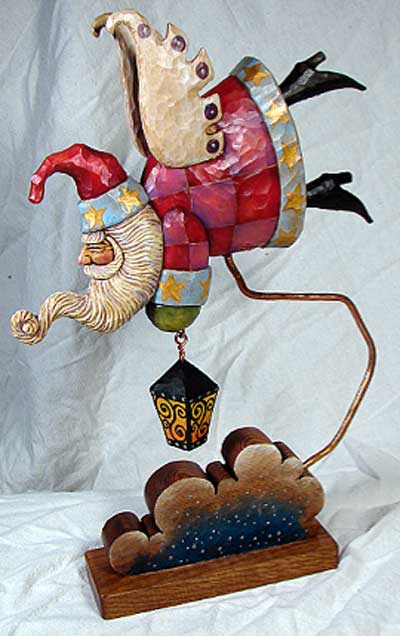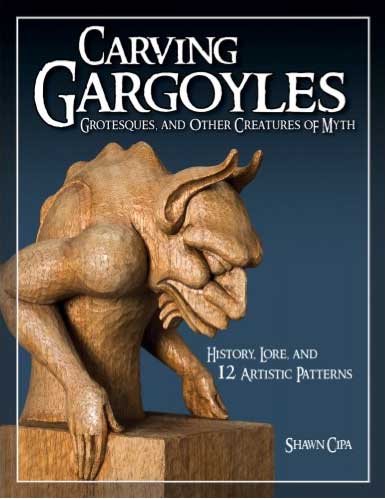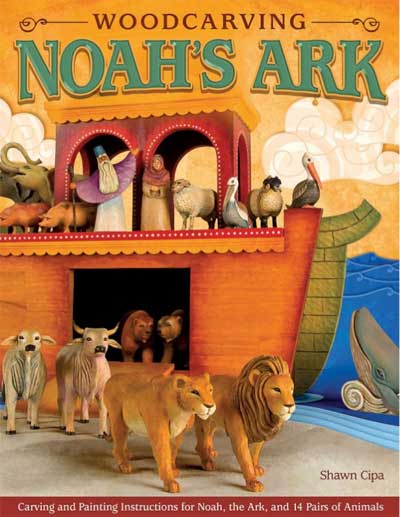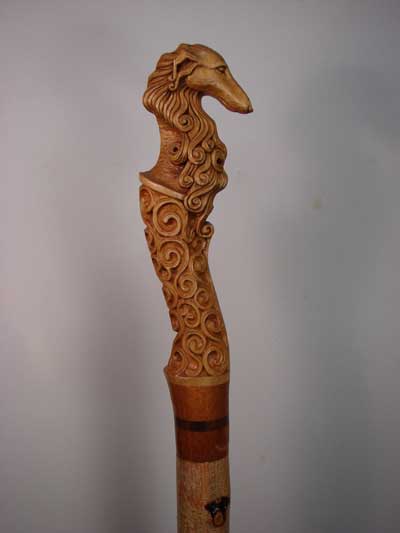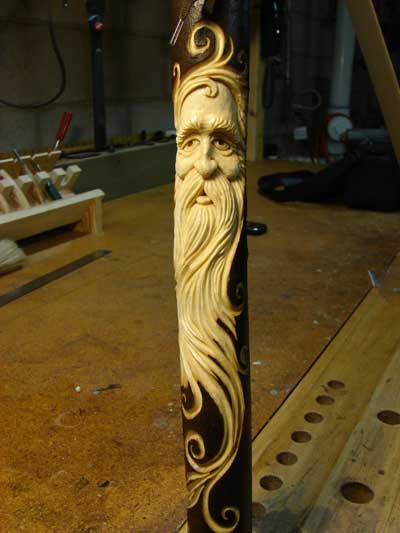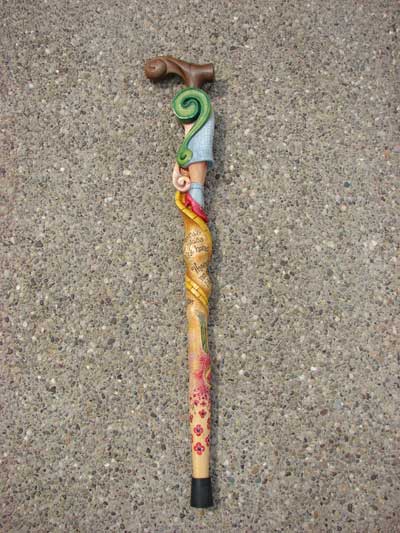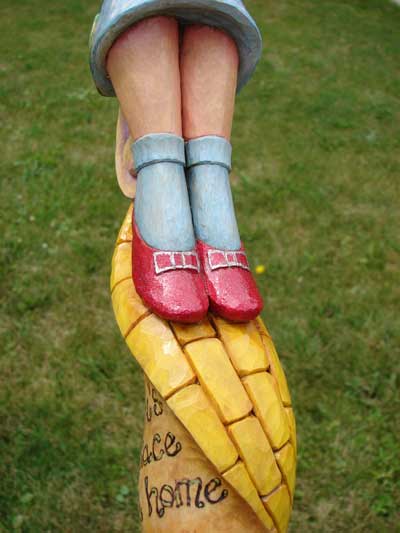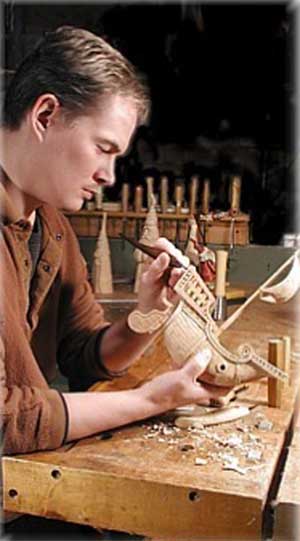
Although Shawn Cipa was raised in an artistic family and “was encouraged and praised in that area when I was growing up,” it wasn’t until he was a young adult in his 20s that he entered the world of woodworking. “I was at a local craft show and saw a woman carving wood spirit walking sticks. I was intrigued by it and thought ‘I bet I could do that.’”
That Christmas, Shawn received some woodcarving tools. “I quickly discovered they were the wrong tools,” he said, but, after acquiring the correct tools, he first tried carving a wood spirit walking stick, then got into folk art Santa Clauses. “When I started carving wood, all those other art mediums pretty much ceased, “ Shawn said. “I still draw, but only to work out my drawings. I still paint, but only to paint my designs.”
Although for the past couple of years, Shawn’s carving has had more of a focus on carved walking sticks, “I really got popular with folk art,” he said: “lots and lots and lots of Santas.”
In fact, Shawn was the winner of a national Santa carving contest in 2000, which led directly into the five books he’s published on various carving subjects. When he did one on Carving Gargoyles, Grotesques and Other Creatures of Myth, “I got a little more stretched,” he said, with more of an architectural style — and he did, in fact, study actual architectural features of gargoyles and grotesques for design inspiration.
Overall, though, “I like to do a lot of whimsical stuff,” Shawn said. “I love antiques and anything that looks old.” He will do research, for example, on “antique toys,” or “vintage Christmas.” “I’m not looking to copy something directly, but looking for that spark.”
One of the projects he’s most proud of was, indeed, somewhat inspired by antique toys — “old German folk art arks that were Biblical teaching toys,” in particular. “Noah’s Ark is one of those grand projects a lot of woodcarvers dream of doing as novices because it’s a big, many-pieced project,” Shawn said.
He himself made many false starts on Noah’s Arks since be began carving in 1993, but finally took it on as a project that became a book about two years ago. “I’m proud of it personally, because I could’ve went all out and made it completely elaborate and intricate, but it’s supposed to be a project for intermediate to beginning woodcarvers.”
Since the ark itself is not a carving, but a woodworking project, Shawn made sure any tools needed were readily available at local home improvement centers, “and I made sure it was all butt joints instead of intricate joints or dovetails. I put a great deal of effort into it, because I wanted them to look at it and not be intimidated. You could be well-accomplished carver and still have fun with the book, depending on how much detail you want to put into it. Or, a beginner could simplify it even more.”
Throughout his work, Shawn said, “I’m catering to two different crowds: the people who buy commissions, and amateur woodcarvers, because of the books.”
For the commission portion of his work — or, at least, his carving work, since Shawn still holds a “day job,” as well — the focus for the past couple of years has been on carved canes and walking sticks. Shawn says he’ll be shifting gear back into a concentration on folk art soon, although still doing canes and sticks to some degree.
“Walking sticks has really stretched my creativity muscles,” he said. “Every time somebody orders a custom cane, I have to come up with a design, that’s feasible, because it’s a functional item.”
That need for functionality also influences his wood choices. Although for figurines, he often uses the popular carving wood basswood, “It’s a soft hardwood and not strong enough for canes,” Shawn said. “It wouldn’t take hits and dings well.”
Instead, he chooses other woods — “all hardwoods because they have to be strong — like maple, black walnut, cherry, birch or poplar. For canes, which he defines as “a short staff with a T-handle,” which are usually in at least two pieces, he often uses multiple species, and he’ll sometimes add non-wood elements, as well, such as soapstone for a decorative element or copper, like old copper plumbing fixtures as tips on the bottom of a cane “so they don’t mushroom out after use.”
Many of his wood spirit walking sticks are carved from maple saplings that Shawn has harvested. “I carved the maple green, within a week or two after cutting. Green maple carves like silk,” he said. He leaves the bark on the stick portion and applies a tung oil or linseed oil finish after carving, which he likes because it turns the bark a dark brown and provides a contrast to the lighter carved areas.
“A lot of the canes I’ve carved were meant to be orthopedic,” Shawn said. Those ordering them were often very particular, and very proud, because “even though they needed a cane, they didn’t want the stigma an institutional cane brings. They wanted to be proud, with a work of art walking around.”
He cites one story in particular, of a Wizard of Oz-inspired cane he took as a commission from a woman whose mother had been diagnosed with aggressive bone cancer. “Her favorite thing in the world was the Wizard of Oz, particularly the movie, and the cane was made to reflect that.”
The cane incorporates Dorothy’s ruby slippers, with the feet placed together and pointed in part because of the need to make the cane functional, standing on the yellow brick road, which winds around the cane to the Emerald City, seen in the distance. “It’s very busy and very loud and, like the movie, very gaudy. You can’t miss it, and that’s how she liked it,” Shawn said.
The daughter told him her mother never let the cane out of her sight and that the family almost buried her with it because she loved it so much. “At the last second, they yanked it out, and now they have it as a keepsake for the family.”
“I had that in mind as I was carving it: something they could hang onto,” Shawn said.
With the canes, the folk art, and “Everything I do, I try to do my very best,” Shawn said.
